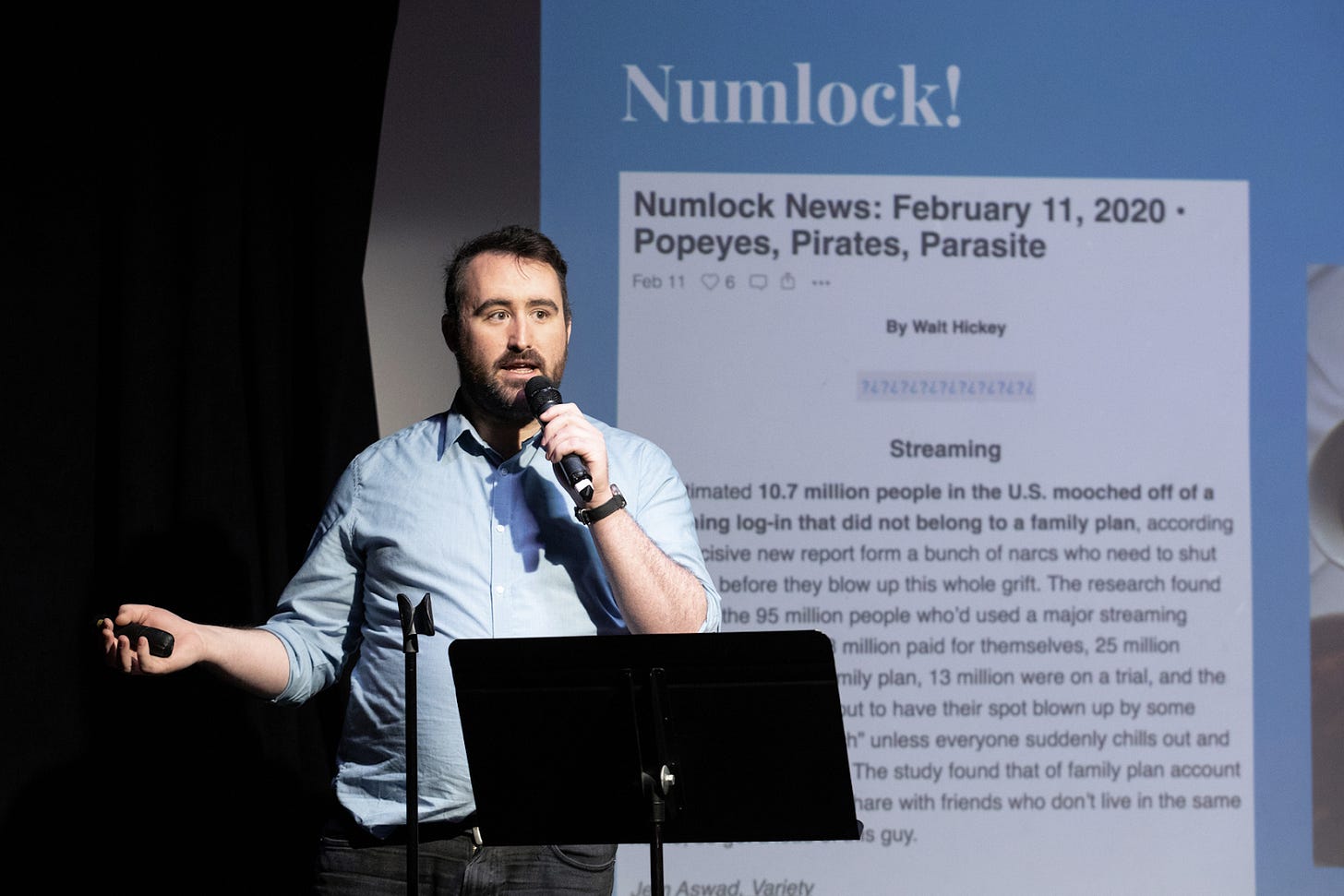
We invited Walt Hickey, author of Numlock News, to share with an audience of Substack writers in New York how he thinks about spinning off multiple newsletters for fun and profit. Walt started off with Numlock News – where he writes about the numbers behind the news – then added paid subscriptions, an Oscar Awards supplement, and a book club.
This transcript has been lightly edited for readability.
Takeaways
Multiple newsletters are a lightweight way to experiment with new ideas.
Use your main newsletter to create spin-offs, so you never have to deal with the “zero subscriber” problem again.
Get creative with your paid subscriptions. You don’t just have to send one free and one paid post. Depending on your topic, you might consider publishing paid content during a peak season, quarterly in-depth reports, or more.
I run a newsletter called Numlock. It’s a daily morning newsletter about the numbers inside the news.
I started it after working at FiveThirtyEight for about five years, where I’d started a newsletter called Significant Digits. As a guy with a math-y background, I realized that my biggest liability as a person in journalism was that I needed to get better at writing, and doing something every day was a really effective way of practicing.
I really enjoyed writing that newsletter, and then it hit a point where the scuttlebutt was that FiveThirtyEight was going to be sold. I looked at where Sig Dig was and realized there was more value in there than we were currently unlocking. The open rate was great. People enjoyed receiving it. In building the case for why FiveThirtyEight should keep me, I actually built the case for why I should leave and start my own newsletter. I did that, and it's been great.
How he started multiple newsletters
My main newsletter is Numlock, it’s my bread and butter. It’s what I've been doing for more than two years now. I have a product that I think is good, and that my audience thinks is good. As a result, I have a good “in” with people who enjoy reading my work. If I were to describe Numlock in Uber-for-pizza terms, what I think of is, “It's Good Morning America for nerdier folks.”
This being Substack, at a certain point, it came time to monetize, so I launched a Sunday edition. For $5 a month, I talk to either a writer who wrote a really cool story that I put in the main newsletter, or I talk to an author who's got a good book out. This is a really fun way to add value.
If you think about traditional media ecosystems like late night shows, there’s a reason they have written jokes in the beginning and then an interview at the end. It’s because interviews are easy to book, and people tend to like them a lot. It’s a nice way to have something that’s less work than the newsletter itself, but gives people more insight into the stories that we find.
But I’ve also started a couple of other spin-off newsletters, one of which is the Numlock Awards Supplement.
I’m a culture writer, and I love predicting the Oscars using math. It's a good time. I started about two years ago and wanted to keep doing it. I think we learn a lot about ourselves, and how we can predict things, through this institution that is very obscure. It's a fun little puzzle.
So I started a pop-up award season newsletter. It runs from November-ish, or whenever I feel like starting it, until Oscar night and the week after. It's a nice opportunity to talk about a thing I'm really passionate about, but not have to throw it at my traditional people who just want to watch Good Morning America and never talk to me again.
That spawned another idea. I love engaging with audiences, and discussion threads are such a cool feature that Substack has built. I wanted a way to tap into that without compelling people who just enjoyed the passive nature of newsletters to participate.
So I thought, again, having interviewed a lot of authors and seeing the response that that gets, my audience is one that enjoys reading things, learning new things, cool ideas, cool books and stuff like that. I figured one way to expand that was through a book club.
The Numlock Book Club is kind of a democracy, and it's also kind of an experiment. The idea was we're going to vote on books to read, and then we're going to vote on these books. Whatever book you pick, we're going to read, then it's basically just going to be a managed reading thing.
We've gone through three so far. We're in the middle of our fourth, and it's really fun. You get a chance to cover things that you wouldn't normally cover. You get to engage with readers that you might not normally be able or willing to, based on how you normally interact with your newsletter.
Spin-offs make it easy to try new things
Here’s the real reason that you should make spin-off newsletters. Who’s having fun in media anymore? I think about this question constantly, because I'm having fun in media, but many other people are not. So I made this list of all the people I could think of that are currently having fun in media:
Top TV talent
Private equity capitalists extracting enormous quantities of wealth for a style of business operation not entirely unlike the episode where Tony Soprano busted up that camping store
Walt Disney
People who make a living directly from their audience
People that get residuals from NBC television shows that aired in the '90s and early 2000s
Jake Paul
I can't be any of these except for one, but it’s really fun. To give you an example of other people who’ve tried this, I’d like to highlight the example of the McElroy brothers, which is a family of brothers who have podcasts.
They started with a podcast called My Brother, My Brother, and Me. Then they tried to do one episode about Dungeons and Dragons, and it went well. So they spun that off and made a podcast called The Adventure Zone, which ended up becoming a lot more popular than the original podcast. Eventually, they started adding some other weird spin-off podcasts. Some of these then turned into other opportunities to cross-promote.
The idea is, if you like The Bachelor, you can listen to Rose Buddies. If you like medical history, you can check out Sawbones, which promotes everything else they have. Everything they do internally plugs into one another.
So if I’m a person who likes the first thing, I can eventually wind my way to other things that I like. Maybe you don't want to listen to Sawbones, but you might be really down for The Adventure Zone. And this also turns into other opportunities like a book, or a graphic novel, or the fact that they had a podcast called The McElroy Brothers Will Be in Trolls 2 and eventually it happened – they're in Trolls 2.
Spin-offs are great. They address a lot of things that are annoying about starting a newsletter from scratch, namely that you know the people who like you the most already. They're the ones who currently subscribe to your newsletter. So you can reach the people who are most likely to subscribe to your other newsletter.
Spin-offs are great. They address a lot of things that are annoying about starting a newsletter from scratch, namely that you know the people who like you the most already.
The Golden Rule I've found is that every new subscriber is slightly easier to get than the previous subscriber, because networks scale. It's very difficult to go from zero to one. Going 10 to 11 is easier. Going 99 to 100 is easier than that, and so on. So you never really need to relive the “zero-subscriber newsletter” that really takes guts to send.
As long as you come into it like that, you can say, “I don't know if this is going to last forever. This is just a fun little thing I'm going to do on the side.” But your spin-offs have an opportunity to bolster the way that you interact with your audience. You might get that hit. You might make a sidebar newsletter that ends up being bigger than your initial one. Nobody really knows what's good anymore, but experimenting a lot is a good way to try that.
Also, collaborations are great. I do my Oscar Awards one with the person I’m dating, who knows much more about the Oscars than I do.
Get creative with paid subscriptions
The internet spent a lot of time figuring out how to really optimize ads. We know a lot of ways to make money off advertising to people. We also now know that, yes, subscriptions are great. Last night I wondered: what is the average frequency with which a paid newsletter sends out paid posts?
I pulled the top 25 Substack newsletters and found that 14 of the 25 were sending about even amounts: one paid post for one free post. Some were more like me, where you do five free, one paid. And then some were the opposite direction, where you get five paid and then one free per week.
So we know what tends to do well when it comes to subscriptions, but I want to point out a few other business models that I think people should try. There are different ways to use subscriptions that are not simply, “Half my posts are behind a paywall and the other half is free.”
For instance, you can use what’s almost like demand-based pricing. If there's an election going on, in October lots of people are going to be interested in that stuff. And so maybe you have something that’s like, “We're an elections newsletter. In October, only paid subscribers get the really timely material.”
On the other hand, you could have a paid-only edition that arrives quarterly or yearly. You just have to figure out what you need to promise and then deliver on that. It doesn't need to be once a week. It doesn't need to be twice a week. It doesn't need to be once a month. As long as you figure out your social contract with your readers, you can do whatever you want. It can come in the form of, “I cover an industry and once a year, you're going to get a big report from me and that's what the money's for.”
You can promise to do 20 paid-only editions per year and only send them when there's actually news on your beat. I'm not going to monetize my Oscars newsletter, but maybe I have one that’s awards all year-round, and then I only send the paid editions when the news is hot, which is going to be in January and February. There are all sorts of ways that you can use ancillary newsletters to both experiment with content and experiment with delivery formats.
For more advice on growing your newsletter, check out “How to build community around your publication.”










